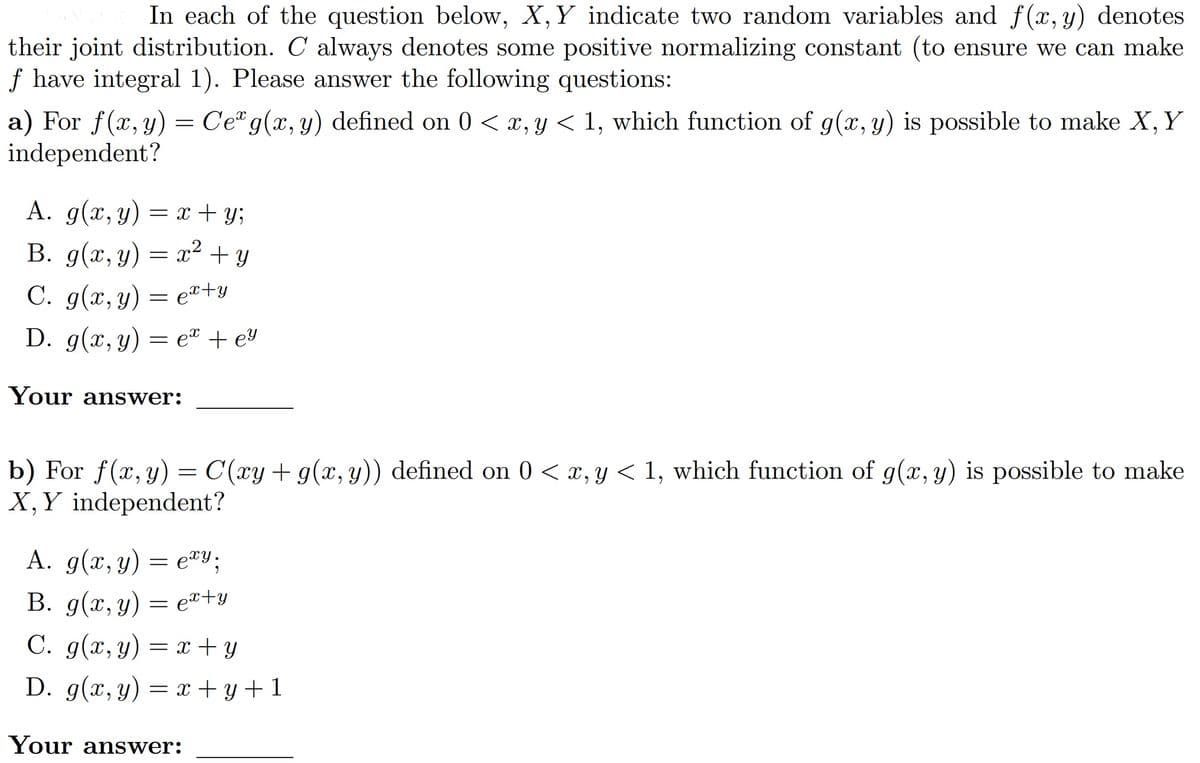In each of the question below, X, Y indicate two random variables and f(x, y) denotes their joint distribution. C always denotes some positive normalizing constant (to ensure we can make f have integral 1). Please answer the following questions: a) For f(x, y) = Ce g(x, y) defined on 0 < x, y < 1, which function of g(x, y) is possible to make X, Y independent? A. g(x, y) = x + y; B. g(x, y) = x² + y C. g(x, y) = ex+y D. g(x, y) = e + ey Your answer: b) For f(x, y) = C(xy + g(x, y)) defined on 0 < x, y < 1, which function of g(x, y) is possible to make X, Y independent? A. g(x, y) = exy; B. g(x, y) = ex+y C. g(x, y) = x + y D. g(x, y) = x + y +1 Your answer:
In each of the question below, X, Y indicate two random variables and f(x, y) denotes their joint distribution. C always denotes some positive normalizing constant (to ensure we can make f have integral 1). Please answer the following questions: a) For f(x, y) = Ce g(x, y) defined on 0 < x, y < 1, which function of g(x, y) is possible to make X, Y independent? A. g(x, y) = x + y; B. g(x, y) = x² + y C. g(x, y) = ex+y D. g(x, y) = e + ey Your answer: b) For f(x, y) = C(xy + g(x, y)) defined on 0 < x, y < 1, which function of g(x, y) is possible to make X, Y independent? A. g(x, y) = exy; B. g(x, y) = ex+y C. g(x, y) = x + y D. g(x, y) = x + y +1 Your answer:
A First Course in Probability (10th Edition)
10th Edition
ISBN:9780134753119
Author:Sheldon Ross
Publisher:Sheldon Ross
Chapter1: Combinatorial Analysis
Section: Chapter Questions
Problem 1.1P: a. How many different 7-place license plates are possible if the first 2 places are for letters and...
Related questions
Question
100%
Joint distribution

Transcribed Image Text:In each of the question below, X, Y indicate two random variables and f(x, y) denotes
their joint distribution. C always denotes some positive normalizing constant (to ensure we can make
f have integral 1). Please answer the following questions:
a) For f(x, y) = Ce g(x, y) defined on 0 < x, y < 1, which function of g(x, y) is possible to make X, Y
independent?
A. g(x, y) = x + y;
B. g(x, y) = x² + y
C. g(x, y) = ex+y
D. g(x, y) = e + ey
Your answer:
b) For f(x, y) = C(xy + g(x, y)) defined on 0 < x, y < 1, which function of g(x, y) is possible to make
X, Y independent?
A. g(x, y) = exy;
B. g(x, y) = ex+y
C. g(x, y) = x + y
D. g(x, y) = x + y +1
Your answer:
Expert Solution
This question has been solved!
Explore an expertly crafted, step-by-step solution for a thorough understanding of key concepts.
This is a popular solution!
Trending now
This is a popular solution!
Step by step
Solved in 2 steps

Recommended textbooks for you

A First Course in Probability (10th Edition)
Probability
ISBN:
9780134753119
Author:
Sheldon Ross
Publisher:
PEARSON


A First Course in Probability (10th Edition)
Probability
ISBN:
9780134753119
Author:
Sheldon Ross
Publisher:
PEARSON
